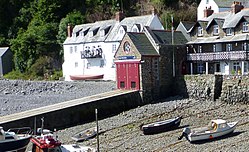
Great Yarmouth and Gorleston lifeboat station is a RNLI base in Norfolk, England. There were originally two separate stations at Great Yarmouth and Gorleston – two coastal towns either side of the River Yare. These were merged in 1926.

Cromer Lifeboat Station is an RNLI station located in the town of Cromer in the English county of Norfolk. The station operates two lifeboats – one for inshore work and the other for offshore work.

Angle Lifeboat Station is located near the village of Angle, on the southern side of the entrance to the Milford Haven Waterway in Pembrokeshire, Wales.

Appledore Lifeboat Station is the base for Royal National Lifeboat Institution (RNLI) search and rescue operations at Appledore, Devon, England. The first lifeboat was stationed in the town in 1825 and the present station was opened in 2001. It operates a Tamar-class all-weather boat (ALB) and an Atlantic 85 B Class inshore lifeboat (ILB).

Ilfracombe Lifeboat Station is the base for Royal National Lifeboat Institution (RNLI) search and rescue operations at Ilfracombe, Devon, England. The first lifeboat was stationed in the town in 1828 and the present station was opened in 1996. For 29 years a second boat was operated from Morte Bay at Woolacombe.

Weymouth Lifeboat Station is the base for Royal National Lifeboat Institution (RNLI) search and rescue operations at Weymouth in Dorset, England. The first lifeboat was stationed in the town in 1869. It currently operates a Severn-class all-weather lifeboat (ALB) and an Atlantic 85 inshore lifeboat (ILB).
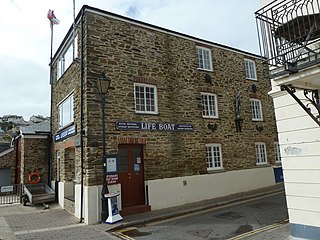
Salcombe Lifeboat Station is the base for Royal National Lifeboat Institution (RNLI) search and rescue operations at Salcombe, Devon in England. The first lifeboat was stationed in the town in 1869. The Salcombe Lifeboat has twice capsized, in 1916 with the loss of 13 lives, and in 1983 with no loss of life. Since 2008 the station has operated a Tamar-class all weather boat (ALB) and an Atlantic 85 inshore lifeboat (ILB).

Sennen Cove Lifeboat Station is the base for Royal National Lifeboat Institution (RNLI) search and rescue operations for the sea around Land's End, Cornwall in the United Kingdom. The first lifeboat was stationed at Sennen Cove in 1853. Since 2009 it has operated a Tamar-class all-weather boat (ALB) and a D-class (IB1) inshore lifeboat (ILB).

Exmouth Lifeboat Station is the base for Royal National Lifeboat Institution (RNLI) search and rescue operations at Exmouth, Devon, England. The first lifeboat was stationed in the town in 1803 and the present station was opened in 2009. In 2014 a new Shannon-class 25-knot all-weather boat (ALB) went on station. Also operated is a D-class (IB1) inshore lifeboat (ILB).

Torbay Lifeboat Station is the base for Royal National Lifeboat Institution (RNLI) search and rescue operations at Brixham, Devon in England. Brixham Lifeboat Station was opened in 1866 but since 1924 has been known as 'Torbay'. Since 2005 it has operated a Severn-class all-weather lifeboat (ALB) together with a D-class (IB1) inshore lifeboat (ILB).

Fishguard Lifeboat Station in located on the quay, at the northern breakwater of Fishguard Harbour, in the community of Fishguard and Goodwick, in the county of Pembrokeshire, Wales.
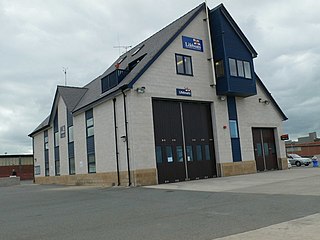
Rhyl Lifeboat Station is operated by the Royal National Lifeboat Institution (RNLI) in the North Wales town of Rhyl. For over 150 years, the Lifeboat Crew in Rhyl have been saving lives at sea. The first lifeboat was stationed in the town in 1852 and the present station was opened in December 2001. The station operates a Shannon-class All-weather lifeboat (ALB), and an D-class (IB1) Inshore lifeboat (ILB).

Lowestoft Lifeboat Station is a Royal National Lifeboat Institution (RNLI) operated lifeboat station in the town of Lowestoft in the English county of Suffolk. The station is located at the mouth of Lowestoft's outer harbour on the South pier. It is one of the oldest lifeboat stations in the United Kingdom, having been established in 1801.

Dover Lifeboat Station is a Royal National Lifeboat Institution (RNLI) lifeboat station located in the town of Dover in the English county of Kent. The station first opened in 1837, coming under the RNLI’s control in 1855.
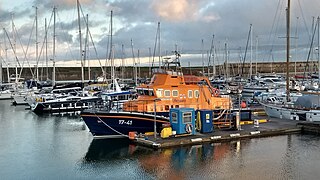
Holyhead Lifeboat Station is a Royal National Lifeboat Institution (RNLI) lifeboat station in the coastal town of Holyhead, Anglesey, Wales. It is one of the three oldest lifeboat stations situated on the North Wales coast, a disused building of which houses the Holyhead Maritime Museum.
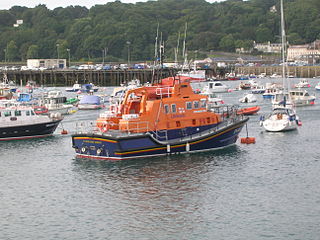
St Peter Port Lifeboat Station is located at St Peter Port, capital of the Bailiwick of Guernsey, and main port of the island of Guernsey, a self-governing British Crown Dependency and one of the Channel Islands.

Plymouth Lifeboat Station is the base for Royal National Lifeboat Institution (RNLI) search and rescue operations at Plymouth in England. The first lifeboat was stationed in the city in the early 1800s. The station moved to its present site at Millbay Docks in 1992, a Grade II-listed three-storey tower. Since 2003 it has operated a Severn-class all-weather boat (ALB) along with an B-class Atlantic inshore lifeboat (ILB).

Swanage Lifeboat Station is a Royal National Lifeboat Institution (RNLI) station located on Peveril Point in the town of Swanage in Dorset, England. It operates two lifeboats, the Shannon-class All-weather lifeboat 13-13 George Thomas Lacy and the D-class (IB1) inshore lifeboat (ILB) Roy Norgrove (D-884).

Longhope Lifeboat Station is the base for Royal National Lifeboat Institution (RNLI) search and rescue operations at Longhope on the island of South Walls, in Orkney, Scotland. It opened in 1874 and since 2004 has operated a Tamar-class lifeboat. In 1969 its lifeboat and crew of eight were lost during a rescue mission.

Campbeltown Lifeboat Station is the base for Royal National Lifeboat Institution (RNLI) lifeboat at Campbeltown in Argyll, Scotland. It opened in 1861 and today operates both inshore and all-weather lifeboats.

